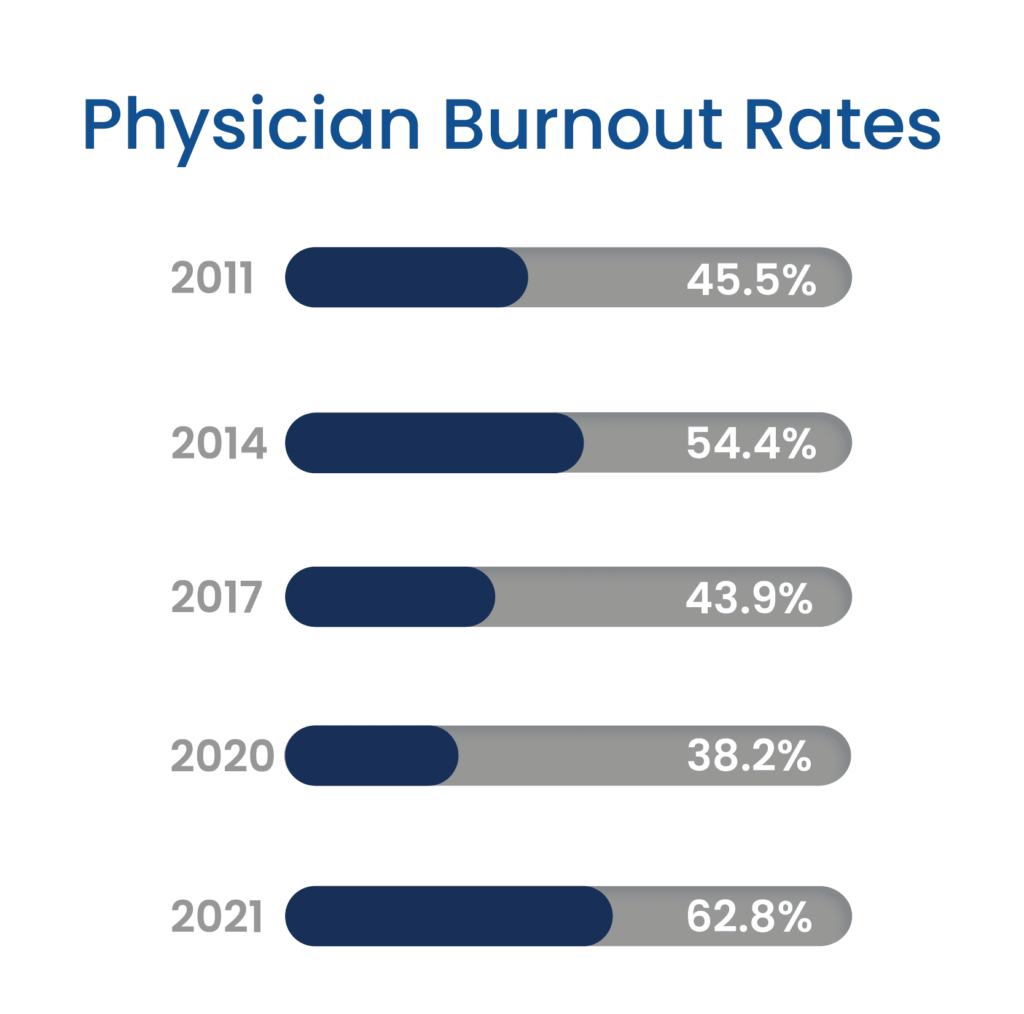Burnout is reaching epic levels. And as more and more healthcare workers hang up their scrubs, the divide between patient demand and the ability to meet it grows larger. It’s having tremendous negative impacts in healthcare environments, particularly where compliance is concerned.

Source: 2022 study published in the Journal of the American Medical Association
Pandemic Healthcare Burnout Isn’t Lingering; It’s Growing
Unsurprisingly, the pandemic wreaked havoc on our nation’s healthcare professionals.
According to one survey by the American Nurses Foundation, over 34% of nurses score their emotional health as “not well” or “non-existent.” They cite feelings of being stressed, overwhelmed, and drained. Moreover, 42% of nurses marked “yes” when asked if they had had a particularly traumatizing or stressful experience at work due to COVID-19. Most damning, 48% said they hoped to leave the nursing field in the next six months.
This data is indicative of a trend among healthcare workers to either leave medicine altogether or to pursue high-paying locum tenens and travel nursing positions. Now, we’re facing a staff shortage for hospitals and healthcare providers, which is causing significant difficulties for providers, staff, and patients alike — particularly when it comes to maintaining crucial healthcare compliance standards.
The Top Causes of Burnout Among Providers
Several key factors are behind the rise in burnout. The current state of the healthcare system — increasing demands on providers and limited resources to fulfill those demands — can exacerbate these factors:
- Excessive workloads due to staffing
- Prohibitive administrative burdens
- Limited say in scheduling or duties
- Lack of top-level organizational support
- Frequent staff turnover and shortages
- Hard-to-use or unfamiliar technology
It comes down to a singular root cause: asking already overburdened healthcare workers to do more with (and for) less. It’s a catalyst that’s causing many long-tenured professionals to deprioritize their career over their own mental health and wellbeing. Often, the result is a career change.

WEBINAR: Adapting To Overcome Healthcare Staff Turnover
The Impacts of Burnout
Outside of staffing struggles and low morale among healthcare workers, the impacts of burnout are creeping into every aspect of operations, and can manifest in major problems for providers:
- Decrease in practice income. Burnout can lead to fewer physicians working fewer hours, which reduces the number of patients seen, treated, and ultimately billed.
- Drop in patient satisfaction. Patients may experience longer wait times for appointments and a decreased confidence level in the care they receive.
- Low morale. As low morale forces staff out, remaining staff pick up more work, which leads to increased exhaustion and frustration — and, in turn, more burnout.
- More time spent on admin. In the U.S., on average, physicians spend 2.6 hours per week fulfilling external quality measures in addition to time spent credentialing and privileging providers and ensuring that new staff members are appropriately trained and comply with policies.
- Decline in compliance. Burnout makes staff less likely to adhere to guidelines and policies. This affects the quality of care patients receive and adds to the burden on healthcare providers.
- Increase in infection rate. Nurses have reported that the more burned out they felt, the less likely they were to comply with hand hygiene protocols. Not following aseptic procedures invariably leads to infection and death.
Ideas To Help Prevent Healthcare Burnout
Addressing medical staff burnout requires a multi-faceted approach that speaks to the job’s physical and emotional demands. Below are some strategies that healthcare organizations can implement to improve staff well-being and reduce burnout.
1. Reduce Administrative Burden
Simplify administrative work and use technology to relieve burnout. Paper processes and manual systems are inefficient and costly, and finding instructions for infrequently used equipment takes time and effort. A good tech solution should be simple, flexible, scalable, transparent, and easy to use. Hospitals should implement these new technology strategies with minimal clinical workflow disruption and provide clinicians with training and support.
2. Improve Training Opportunities
Speaking of training, nurses under 30 report valuing on-the-job training and continuing education. Thankfully, it’s easier than ever for employers to offer clinical and soft skills courses through an online learning management system (LMS) with customizable course bundles. This creates a positive work environment and a skilled workforce that remains invested in their professional development.
3. Ask Staff What They Need
It’s as simple as asking people what will make their jobs easier. We must empower healthcare workers to speak up and advocate for themselves and their departments. No one knows what a medical staff needs more than the staff themselves, so it’s time to start listening. Even if there’s no readily available solution, fostering an open dialog can lead to collaboration that solves problems. And, all the while, staff will feel confident that they have the ear of decision-makers who will advocate for them.
4. Encourage Self-Care
Healthcare staff face unprecedented shortages and are taking on excessive patient workloads, causing physical and emotional burnout. Employers can support their staff’s well-being by incorporating mental health training into onboarding and ongoing training programs. Numerous education platforms offer stress management and self-care resources, such as MedTrainer’s course on The Value of Critical Incident Stress Debriefings for Healthcare Workers.
5. Enact and Enforce Helpful Policies
Policies and standards help alleviate confusion and create a benchmark standard for every person to follow. This eliminates ambiguity in the workplace and sets measurable expectations for what’s right vs. wrong and establishes the line between corrective action vs. education and training. For example, enacting an infection control plan to ensure your facility follows cleanliness protocols is a simple way to foster better results and create compliance standards.
These strategies not only improve staff morale and reduce burnout, they also contribute to a safer and more compliant healthcare environment by reducing errors, improving patient outcomes, and promoting teamwork and collaboration among staff.
Creating a Better Future To Prevent Healthcare Burnout
Healthcare faces infinite challenges, including a shortage of qualified healthcare professionals and high rates of burnout. Organizations need to prioritize employee retention and experience to address these issues.
Hospital leaders can achieve this by offering competitive salaries, benefits, and professional development opportunities, and by creating a positive and supportive work environment. By investing in employees, healthcare organizations can improve their workforce and ensure the delivery of high-quality patient care.
Additionally, improving employee retention and experience can help reduce costs associated with hiring and training new staff. The success of these efforts will shape the future of healthcare. It’s essential to act now, to ensure the industry’s long-term health.
